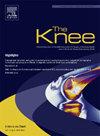Novel anatomical findings of the superficial medial collateral ligament during knee flexion: Anatomical and histological findings
IF 1.6
4区 医学
Q3 ORTHOPEDICS
引用次数: 0
Abstract
Background
During anatomical medial collateral ligament (MCL) reconstruction, the apex of the medial femoral epicondyle (ME-apex) is a significant bony landmark. The purpose of the present study was to evaluate the anatomical relationship between the superficial MCL (sMCL) and the ME-apex using gross anatomical, and histological observations.
Methods
Eight unpaired cadaveric knees were studied. The sMCL was traced from its tibial attachment, and its course at the ME-apex level was documented. The dynamic morphology of the sMCL in relation to the ME-apex was then observed throughout the range of motion, from full knee extension to 90° of knee flexion. Second, the femur, including the sMCL, was cut in the axial plane at the level of the ME-apex. Using this axial section, the anatomical relationships between the sMCL, ME-apex, and depression posterior to the ME-apex, and the morphology of the sMCL femoral attachment were examined histologically.
Results
Gross anatomical observation showed that the sMCL covered the ME-apex in full knee extension. As the knee flexed, the sMCL shifted posteriorly and the ME-apex became visible. At 90° knee flexion, two separate bundles of sMCL fibers with different directions were observed. There was no direct insertion of the sMCL femoral attachment anterior to the ME-apex, only from the ME-apex to the depression posterior.
Conclusion
The sMCL has the direct insertion from the ME-apex of the femur to the depression posterior to it, and shows two separate proximal fiber bundles during knee flexion. These findings offer valuable insights for improving anatomical MCL reconstruction techniques.
求助全文
约1分钟内获得全文
求助全文
来源期刊

Knee
医学-外科
CiteScore
3.80
自引率
5.30%
发文量
171
审稿时长
6 months
期刊介绍:
The Knee is an international journal publishing studies on the clinical treatment and fundamental biomechanical characteristics of this joint. The aim of the journal is to provide a vehicle relevant to surgeons, biomedical engineers, imaging specialists, materials scientists, rehabilitation personnel and all those with an interest in the knee.
The topics covered include, but are not limited to:
• Anatomy, physiology, morphology and biochemistry;
• Biomechanical studies;
• Advances in the development of prosthetic, orthotic and augmentation devices;
• Imaging and diagnostic techniques;
• Pathology;
• Trauma;
• Surgery;
• Rehabilitation.
 求助内容:
求助内容: 应助结果提醒方式:
应助结果提醒方式:


